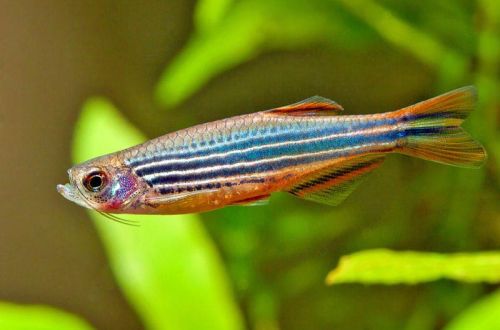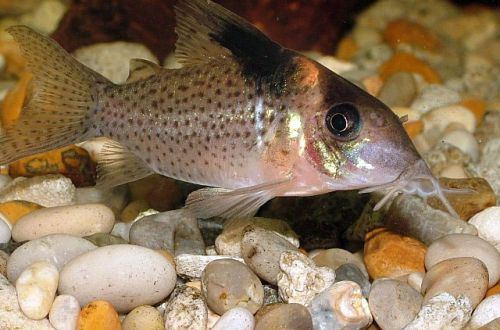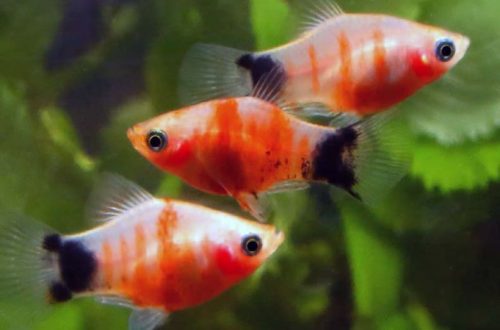
Orange Danio
Orange Danio or Danio orange-finned, scientific name Danio kyathit, belongs to the family Cyprinidae (Cyprinidae). Beautiful active fish that can become a decoration of any freshwater aquarium. What is also facilitated by unpretentiousness and ease of maintenance, good compatibility with other species.

Contents
Habitat
It comes from Southeast Asia from the territory of the northern part of Myanmar (Burma) from the Kachin region – one of the most biodiverse regions of the planet, which is currently heavily affected by human activities.
The fish inhabits the upper basin of the Irrawaddy River. It occurs in small rivers and channels with dense vegetation, the substrate consists of stones mixed with silt. The water is colored brownish due to the abundance of tannins resulting from the decomposition of plant organic matter.
Brief information:
- The volume of the aquarium – from 80 liters.
- Temperature – 16-26°C
- Value pH — 6.0–7.0
- Water hardness – 1–5 dGH
- Substrate type – any dark
- Lighting – any
- Brackish water – no
- Water movement – light or moderate
- The size of the fish is about 4 cm.
- Food – any food
- Temperament – peaceful
- Keeping in a group of 8-10 individuals
Description
Adults reach a length of about 4 cm. The back, abdomen and fins have a rich orange color. Large longitudinal blue stripes run along the body. Sexual dimorphism is weakly expressed. Distinguishing males from females is problematic due to their similarity.
Food
Not demanding on the composition of food. In a home aquarium, only dry food can be accepted, for example, flakes, granules of a suitable size. The inclusion of live or frozen foods (bloodworm, brine shrimp) in the diet is welcome.
Maintenance and care, arrangement of the aquarium
Tank sizes for long term care should start at 80 litres, enough to keep a small flock of Orange Danios. The design uses dark soil, dense plantings of aquatic plants, driftwood and other elements that can serve as a shelter for fish.
It is important to provide stable water conditions with suitable hydrochemical values and avoid sudden temperature changes and pH and dGH surges. The quality of water largely depends on the operation of the filtration system and a number of mandatory procedures. At a minimum, it is worth regularly cleaning the aquarium of organic waste (food leftovers, excrement) and weekly replacing part of the water with fresh water.
Important! The presence of a lid will prevent the fish from accidentally jumping out of the aquarium.
Behavior and Compatibility
Peaceful schooling fish, prefers to be in a group of at least 8-10 individuals. With a smaller amount, it can become shy, and the life span is significantly reduced.
It is characterized by high mobility, which may be excessive for some slow-moving species. Otherwise perfectly compatible with other non-aggressive fish of comparable size.
Reproduction / breeding
Under the right conditions, spawning is not uncommon. Fish scatter eggs on the substrate or in thickets of plants. There is no parental care. The incubation period lasts 24-36 hours, after a few more days the fry will begin to swim freely in search of food.
In the main aquarium, fry have a minimal chance of growing to adulthood. The main reason is predation by other fish. On occasion, even their own parents will surely feast on fry. Those who escape the fate of being eaten will experience a lack of food.
Juveniles can be saved by moving eggs or fry that have already appeared to a separate tank with identical water conditions. The set of equipment used consists of a heater and a simple airlift filter with a sponge as the filter material. A separate light source is not required, the light coming from the room will be enough. Maintenance procedures are similar to the main aquarium.
Feed with specialized powdered food or, if available, brine shrimp nauplii.
Fish diseases
In a balanced aquarium ecosystem with species-specific conditions, diseases rarely occur. Often, diseases are caused by environmental degradation, contact with sick fish, and injuries. If this could not be avoided and the fish shows clear signs of illness, then medical treatment will be required. Read more about symptoms and treatments in the Aquarium Fish Diseases section.





